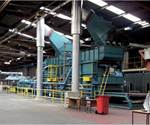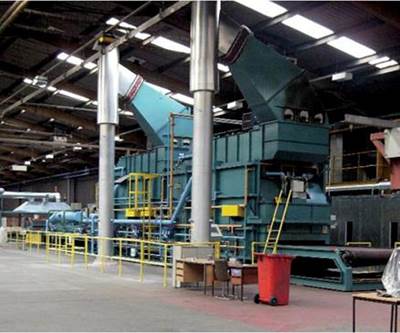Carbon fiber recycling: Ongoing research
There is much ongoing research in the area of recycling carbon fiber.
There is much ongoing research in the area of recycling carbon fiber. Among other things, researchers are looking for better ways to deal with contaminated carbon fiber-reinforced polymer (CFRP) scrap, methods to improve the overall properties of reclaimed fibers, and approaches to improve the processability of reclaimed fibers.
A team lead by Dr. Nicholas Warrior and Dr. Steve Pickering at the University of Nottingham (U.K.) has been studying the use of fluidized bed technology. The group believes the approach is well suited for end-of-life components that may contain a mixture of materials and contaminants and, therefore, are unsuitable for other recycling methods. In the fluidized bed process, crushed composites scrap material is placed in a reactor on a grate, and a stream of fluid (in this case, a gaseous airstream) is forced up through the material at a temperature of 550°C/1022°F. Organic material, including the composite’s resin matrix, is oxidized. However, the velocity of the airflow is such that as the organics burn off, the lightweight fiber is forced upward while heavier matter, such as metallic material, remains in the reactor “bed.”
The now clean fibers are removed from the reactor by the gas stream, which propels them into a cyclone separator, a conical/cylindrical chamber in which the air flows in a downward spiral pattern, and then is directed upward through the center of the chamber and flows out the top. The chamber geometry and airflow rate are set in such a way that carbon fibers in the tornado-like airstream are driven outward by centrifugal force, strike the outside wall and fall to the chamber bottom, where they can be collected. The process also provides users the potential to recover the heat energy from the fully oxidized polymer and use it to reduce the system’s energy consumption. However, according to Pickering, carbon fibers recovered using this approach currently exhibit a loss of strength, ranging from 25 to 50 percent.
However, Pickering sees great potential in the use of supercritical fluids in such processes. At a temperature and pressure above their thermodynamic critical point, these fluids can diffuse through the composite solids like a gas and then dissolve the materials like a liquid. Supercritical fluids, such as propanol, are being tested in thermal fluid processes under high pressure and at temperatures of 200°C to 300°C (392°F to 572°F) to break down epoxy resin into more elementary materials that, potentially, could be reused as chemical products. After processing, high-quality clean carbon fibers can be recovered. The reclaimed fibers reportedly retain up to 97 percent of the tensile strength of the virgin material, with no change in modulus.
Adherent Technologies Inc. (Albuquerque, N.M.) also continues research into carbon fiber recycling. Most recently, the company has developed a multistage recycling approach to address the thermoplastic toughened layers between the standard epoxy composite on Boeing’s 787. Adherent’s process is designed not only to reclaim the fiber but also to process the polymeric waste, breaking it down into more basic chemical building blocks that subsequently could be preprocessed into valuable chemicals or fuels.
Meanwhile, at Imperial College (London, U.K.), researchers are conducting extensive mechanical testing of composites manufactured from recycled fibers. Failure mechanisms are being used to build models and predict the performance of composites made from recycled fibers. One intriguing result, so far, is that testing indicates that when reclaimed fiber bundles held together by pyrolytic char are used as a reinforcement in a new molded product, they actually enhance the fracture toughness of the composite.
Related Content
Watch: A practical view of sustainability in composites product development
Markus Beer of Forward Engineering addresses definitions of sustainability, how to approach sustainability goals, the role of life cycle analysis (LCA) and social, environmental and governmental driving forces. Watch his “CW Tech Days: Sustainability” presentation.
Read MoreRecycling end-of-life composite parts: New methods, markets
From infrastructure solutions to consumer products, Polish recycler Anmet and Netherlands-based researchers are developing new methods for repurposing wind turbine blades and other composite parts.
Read MoreBio-based acrylonitrile for carbon fiber manufacture
The quest for a sustainable source of acrylonitrile for carbon fiber manufacture has made the leap from the lab to the market.
Read MorePlant tour: Daher Shap’in TechCenter and composites production plant, Saint-Aignan-de-Grandlieu, France
Co-located R&D and production advance OOA thermosets, thermoplastics, welding, recycling and digital technologies for faster processing and certification of lighter, more sustainable composites.
Read MoreRead Next
Carbon fiber reclamation: Going commercial
As the first commercial-scale carbon fiber recycling operations go online, research continues into both recycling alternatives and applications for recyclate.
Read MorePlant tour: Daher Shap’in TechCenter and composites production plant, Saint-Aignan-de-Grandlieu, France
Co-located R&D and production advance OOA thermosets, thermoplastics, welding, recycling and digital technologies for faster processing and certification of lighter, more sustainable composites.
Read MoreDeveloping bonded composite repair for ships, offshore units
Bureau Veritas and industry partners issue guidelines and pave the way for certification via StrengthBond Offshore project.
Read More

















.jpg;maxWidth=300;quality=90)







